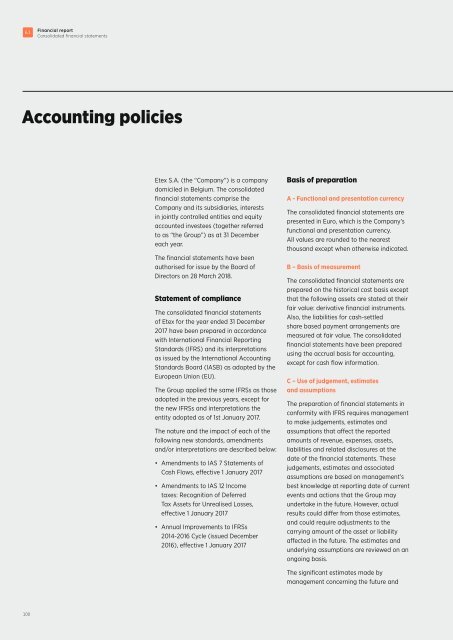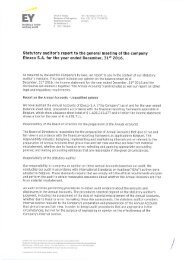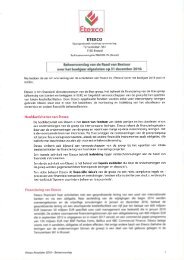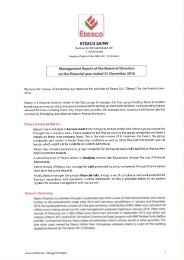Etex-AR2017-WEBSITE
You also want an ePaper? Increase the reach of your titles
YUMPU automatically turns print PDFs into web optimized ePapers that Google loves.
6.1<br />
Financial report<br />
Consolidated financial statements<br />
<strong>Etex</strong> Annual Report 2017<br />
Financial report<br />
Consolidated financial statements<br />
Accounting policies<br />
<strong>Etex</strong> S.A. (the “Company”) is a company<br />
domiciled in Belgium. The consolidated<br />
financial statements comprise the<br />
Company and its subsidiaries, interests<br />
in jointly controlled entities and equity<br />
accounted investees (together referred<br />
to as “the Group”) as at 31 December<br />
each year.<br />
The financial statements have been<br />
authorised for issue by the Board of<br />
Directors on 28 March 2018.<br />
Statement of compliance<br />
The consolidated financial statements<br />
of <strong>Etex</strong> for the year ended 31 December<br />
2017 have been prepared in accordance<br />
with International Financial Reporting<br />
Standards (IFRS) and its interpretations<br />
as issued by the International Accounting<br />
Standards Board (IASB) as adopted by the<br />
European Union (EU).<br />
The Group applied the same IFRSs as those<br />
adopted in the previous years, except for<br />
the new IFRSs and interpretations the<br />
entity adopted as of 1st January 2017.<br />
The nature and the impact of each of the<br />
following new standards, amendments<br />
and/or interpretations are described below:<br />
• Amendments to IAS 7 Statements of<br />
Cash Flows, effective 1 January 2017<br />
• Amendments to IAS 12 Income<br />
taxes: Recognition of Deferred<br />
Tax Assets for Unrealised Losses,<br />
effective 1 January 2017<br />
• Annual Improvements to IFRSs<br />
2014-2016 Cycle (issued December<br />
2016), effective 1 January 2017<br />
Basis of preparation<br />
A - Functional and presentation currency<br />
The consolidated financial statements are<br />
presented in Euro, which is the Company’s<br />
functional and presentation currency.<br />
All values are rounded to the nearest<br />
thousand except when otherwise indicated.<br />
B – Basis of measurement<br />
The consolidated financial statements are<br />
prepared on the historical cost basis except<br />
that the following assets are stated at their<br />
fair value: derivative financial instruments.<br />
Also, the liabilities for cash-settled<br />
share based payment arrangements are<br />
measured at fair value. The consolidated<br />
financial statements have been prepared<br />
using the accrual basis for accounting,<br />
except for cash flow information.<br />
C – Use of judgement, estimates<br />
and assumptions<br />
The preparation of financial statements in<br />
conformity with IFRS requires management<br />
to make judgements, estimates and<br />
assumptions that affect the reported<br />
amounts of revenue, expenses, assets,<br />
liabilities and related disclosures at the<br />
date of the financial statements. These<br />
judgements, estimates and associated<br />
assumptions are based on management’s<br />
best knowledge at reporting date of current<br />
events and actions that the Group may<br />
undertake in the future. However, actual<br />
results could differ from those estimates,<br />
and could require adjustments to the<br />
carrying amount of the asset or liability<br />
affected in the future. The estimates and<br />
underlying assumptions are reviewed on an<br />
ongoing basis.<br />
The significant estimates made by<br />
management concerning the future and<br />
other key sources of estimation uncertainty<br />
at the balance sheet date that have a<br />
significant risk of causing a material<br />
adjustment to the carrying amount of<br />
assets and liabilities within the next<br />
financial year are discussed below.<br />
Impairment of non-financial assets<br />
The recoverable amount of the cashgenerating<br />
units tested for impairment<br />
is the higher of its fair value less costs to<br />
sell and its value in use. Both calculations<br />
are based on a discounted cash-flow<br />
model. The cash flows are derived from<br />
the budget for the next three to ten<br />
years. The recoverable amount is most<br />
sensitive to the discount rate used for<br />
the discounted cash flow model as well<br />
as the expected future cash inflows and<br />
the growth rate used for extrapolation<br />
purposes. The key assumptions used to<br />
determine the recoverable amount for the<br />
different cash-generating units, including<br />
a sensitivity analysis, are further explained<br />
in note 8.<br />
Provisions The assumptions that have<br />
significant influence on the amount of<br />
the provisions are the estimated costs,<br />
the timing of the cash outflows and the<br />
discount rate. These assumptions are<br />
determined based on the most appropriate<br />
available information at reporting date.<br />
Further details about the assumptions used<br />
are given in note 19.<br />
Employee benefits The measurement<br />
of the employee benefits is based on<br />
actuarial assumptions. Management<br />
believes that the assumptions about<br />
discount rates, expected rates of return on<br />
assets, future salary increases, mortality<br />
rates and future pension increases used for<br />
these actuarial valuations are appropriate<br />
and justified. They are reviewed at each<br />
balance-sheet date. However, given the<br />
long-term nature of these benefits, any<br />
change in certain of these assumptions<br />
could have a significant impact on the<br />
measurement of the related obligations.<br />
Further details about assumptions used are<br />
given in note 21.<br />
Recognition of deferred tax assets on<br />
tax losses carried forward Deferred tax<br />
assets are recognised for all unused tax<br />
losses to the extent that it is probable<br />
that taxable profit will be available<br />
against which the losses can be utilised.<br />
Significant management judgment is<br />
required to determine the amount of the<br />
deferred tax assets that can be recognised,<br />
based upon the likely timing and the level<br />
of future taxable profits together with<br />
future tax planning strategies. The potential<br />
utilisation of tax losses carried forward is<br />
based on budgets and forecasts existing at<br />
reporting date. Actual results could differ<br />
from these budgets with an impact on the<br />
utilisation of tax losses carried forward.<br />
Cash-settled share-based payment<br />
transaction The Group measures the<br />
cost of cash-settled transactions with<br />
employees by reference to the fair value of<br />
the equity instruments at each reporting<br />
date. Estimating fair value for share-based<br />
payment transactions requires determining<br />
the most appropriate valuation model,<br />
which is dependent on the terms and<br />
conditions of the grant. This estimate also<br />
requires determining the most appropriate<br />
inputs to the valuation model including<br />
the expected life of the share option,<br />
volatility and dividend yield and making<br />
assumptions about them. The assumptions<br />
and model used for estimating fair value<br />
for share-based payment transactions are<br />
disclosed in note 22.<br />
Financial instruments To measure<br />
the fair value of financial assets that<br />
cannot be derived from active markets,<br />
management uses a valuation technique<br />
based on discounted future expected<br />
cash flows. The inputs of this model<br />
require determining a certain number<br />
of assumptions, including discount rate,<br />
liquidity risk and volatility, subject to<br />
uncertainty. Changes in these assumptions<br />
could have an impact on the measurement<br />
of the fair value. Further details are given<br />
in note 16.<br />
D – Basis of consolidation<br />
Subsidiaries Subsidiaries are entities that<br />
are controlled, directly or indirectly, by the<br />
Company.<br />
Control is achieved when the Group is<br />
exposed, or has rights, to variable returns<br />
from its involvement with the investee<br />
and has the ability to affect those returns<br />
through its power over the investee.<br />
Specifically, the Group controls an investee<br />
if, and only if, the Group has:<br />
• Power over the investee (i.e.,<br />
existing rights that give it the<br />
current ability to direct the relevant<br />
activities of the investee)<br />
• Exposure, or rights, to variable returns<br />
from its involvement with the investee<br />
• The ability to use its power over<br />
the investee to affect its returns<br />
Generally, there is a presumption that a<br />
majority of voting rights result in control.<br />
To support this presumption and when<br />
the Group has less than a majority of the<br />
voting or similar rights of an investee, the<br />
Group considers all relevant facts and<br />
circumstances in assessing whether it has<br />
power over an investee, including:<br />
• The contractual arrangement with the<br />
other vote holders of the investee<br />
• Rights arising from other<br />
contractual arrangements<br />
100 101
















